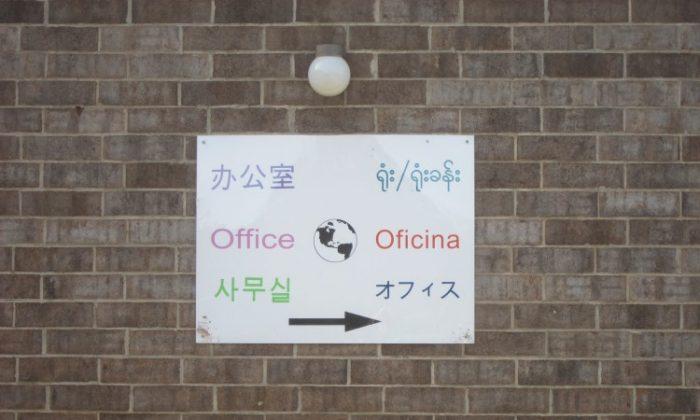Recent reports estimate that by 2020, more than half of all public school students are likely to have a non-English-speaking background.
Anastasia, a bright little girl with striking blonde hair and eyebrows to match, spoke English as she played with her friends from Korea, Italy, Turkey, and America. In a split second, Anna, switched her language to Russian as she turned to speak with her younger brother and mother.
Their conversation appeared to be about whether to spend the day playing with friends indoors or outdoors, but an outsider unfamiliar with the Russian language could only guess—it was a family meeting held in secret, right in the open.
This multicultural playground scene is not in a big city such as New York or Los Angeles—it is in a typical suburban neighborhood in North Carolina.
Mariana Haynes is the author of the report, “The Role of Language and Literacy in College- and Career-Ready Standards: Rethinking Policy and Practice in Support of English Language Learners,” and senior fellow with the Alliance for Excellent Education—a national policy organization that advocates for every child to graduate from high school prepared for college and life, based in Washington, D.C.
Haynes is concerned that as states around the nation put into place the new Common Core State Standards (CCSS), they might forget to make policies and practices to ensure that students who are learning English are also learning other subjects in depth.
Putting the Pieces Together
American demographics have changed over the decades. The number of school-age children who spoke a language other than English in the home rose drastically from 4.7 million (10 percent) to 11.2 million (20 percent) between 1980 and 2009, according to Haynes’s report.
In a 2006–2008 American Community Survey from the U.S. Census Bureau, over 55 million people nationwide were found to speak a language other than English at home. Nearly half of the survey participants said that they spoke English “less than very well.” Over half of the non-English speakers spoke Spanish, but Russian, Korean, and Polish were just of few of the common languages spoken in U.S. homes.
Back on the playground, Anastasia’s mother, Irina Cocieru, proudly pointed out her neighbor’s daughters. They arrived from Italy one year ago. The parents are working on a contract at a nearby university.
“When I met them, they didn’t speak any word of English, and now you won’t hear any accent,” said Cocieru, who gives credit to the public schools’ English as a Second Language (ESL) programs.
In just three to six months’ time, the girls in the family were speaking English fluently, and they even stopped speaking Italian—which can often be startling for parents that speak English as a second language.
Cocieru came to America nearly seven years ago with her husband, a doctor, and their young child. When they first arrived in New York, they lived in a Romanian community. Cocieru said that she found it hard to learn English when she first arrived, but she was happy to find a child care center for her then 3-year-old. In one month, Anastasia was speaking English.
“Everyone was amazed, and I don’t know how she made it,” said Cocieru. “Maybe it’s a human being’s need to communicate. We want to speak.”
Chapel Hill-Carrboro City Schools (CHCCS) has nearly 1,150 English Language Learner (ELL) students enrolled in the district, and the district has an excellent reputation.
“They do amazing work,” said Cocieru.
According to the CHCCS Web page, every school in the district has an ESL program. There are a handful of Spanish-English programs and one Chinese-English dual language program, and they make communication with ESL parents a priority, “no matter what language they speak.”
Jae Myung, researcher at the University of North Carolina at Chapel Hill (UNC), describes his 5-year-old daughter’s class as “internationally intense.” According to a teacher, it is a traditional elementary public school, but it includes signs in multiple languages to “make the students feel at home.”
Myung and his wife are both from Korea, and both of them work at a university. But even in the United States, the Myungs decided that Korean would remain the dominant language in their home. Their concern was that their daughter would not learn Korean if she was exposed to English first.
Myung said that since his daughter started kindergarten, she has been speaking a lot of English, and that it is mainly due to an ESL class she is taking.
In her class of 20 students, over half are new ELL students: five are Korean, and many are from Japan and China. According to Myung, “Their parents are visiting scholars, so they stay just one or two years.”
Universities Diversifying K-12
It may not have been intentional, but as universities have diversified, so have K-12 institutions. At two major universities, Duke University and UNC, often there are visiting scholars, clinical researchers, or overseas professors working. Spouses and children are inevitably part of the package.
Recent data from the Institute of International Education (IIE), a nonprofit U.S. organization that advances international education exchange, indicated that studying abroad is gaining popularity around the globe. Universities are recruiting overseas students, and professors and clinical researches from various countries travel to America on academic grounds.
Maria Maschauer, visitors and special events coordinator for the literature program at Duke University, said that visiting scholars usually bring their spouses and children along for the ride. One family member may speak English and the others may not, so they translate for each other, said Maschauer.
Once the basic communication strategy is squared away, the next steps are to buy a cellphone, determine transportation options, find a new place to live, and enroll their children in an appropriate school, according to Maschauer.
She said, “If they choose a school that has a lot of diversity, they kind of fit in a little better. They seem very happy with the schools here.”
Making ELL and ESL a Priority
While some schools are doing an excellent job, Haynes said that other teachers have not had a single day of training for ELL students.
According to Hayes, the Council of Chief State School Officers, a partner in leading nationwide the CCSS, will have to “take on a really heavy lift” in crafting - proficiency standards that will correspond to the CCSS and the Next Generation Science Standards.
Haynes said that many of the new college and career-ready standards put out by Achieve, the National Research Council, and others require students to work at a higher level.
“So for English language learners—where language becomes an issue—this has to be dealt with upfront and be very focused,” said Haynes. “It can’t be sort of an afterthought, after a lot of other things are being put into place.”
“They have to be thought about from the get-go, as states are in this transition period where they are trying to create systems to support the implementation of these new standards,” Haynes said.
Grown-Ups Want to Learn, Too
Cocieru said that while her children are naturally picking up English by playing with their friends, for her it is more difficult.
“Kids are playing, but adults are not playing,” said Cocieru. “They just have to live day to day and there’s not enough time.”
But Cocieru still strives to better her English skills, and she likes to spend time with retirees in the neighborhood.
“Here, there are many retired people who have time, and they help very much. They can help because they are very patient—they talk slowly and correctly,” said Cocieru. “They have time to tell what they want to tell, and listen and understand what you mean.”
While walking with her toddler, Deryo Oszler said that it had been four days since she moved into her new home. Her husband is performing doctorate research at a local university. The family of four will live in North Carolina for two years before returning to Turkey.
Oszler was on her way to catch up with the nearby elementary school teachers to see how her oldest daughter was doing with learning English in school.
“Turkey is so different than America,” said Oszler.
When she lived in Turkey, Oszler thought that her English was passable, but she now feels that her pronunciation is completely wrong. She thinks that no one can understand what she is saying, though she speaks quite well.
Oszler’s push to improve her English proficiency is understandable, as speaking more than one language is common in this diverse town.
“This is America,” said Oszler with shining eyes and an upbeat tone. Describing the residents in her new apartment home, she said, “Everyone is from somewhere.”
Maschauer said that it can be pretty scary for visiting scholars when they first arrive. “But hopefully they will find a friend, and myself. … I’m always here for them. Sometimes they bring their kids in,” she said.
“I think if we all had all that when we were growing up then—and even now, the world would be such a better place,” added Maschauer. “We might have more tolerance if we grew up together.”
The Epoch Times publishes in 35 countries and in 19 languages. Subscribe to our e-newsletter.








